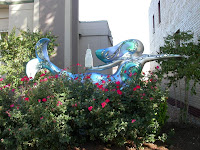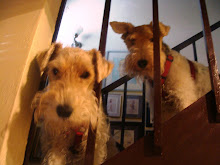Simba asked an intriguing question in response to my post about the three -- count 'em three -- Harrys on DWB: "Is there a word for a group of Harrys?" You know, kind of like a pride of lions, or a gaggle of geese, or a herd of cattle.So what about a _______ of Harrys???Anyone up for the Name Game?
For inspiration, see the article below. (But what was the person who identified a "mute of hounds" possibly thinking?)(And while you're at it, what is the plural of Harry? Harrys? Or Harries? Mom says she is pretty harried just thinking about it!!Hmmm. Could she be thinking about a harry of Harrys???
Just Harry
The Name Game — January - February 1997
by Janice Welsh
Most people know that fish hang out in schools and sheep gather in flocks. But have you ever heard of a pride of lions? How about a kettle of hawks or a charm of finches? The English language has more than 1,000 names for groups of things.
The names for groups of fish and wildlife date back to the Middle Ages,when knights and lords on horseback chased all kinds of animals. Many of the words used to describe groups of animals were hunting terms. Hunters might pursue a dray of squirrels, a fall of woodcock, or a spring of teal. Herd is one term people still use to describe a group deer, cattle, or elephants.
Where Do Names Come From?
Many names for clusters of critters are listed below. As you look at the names, think about what might have led someone to choose a particular one. The choice might have been inspired by:
An animal's action - a leap of leopards
A sound the animal makes - a murmuration of starlings
A repetition of word sounds - a gaggle of geese
What people think about the animals - a richness of martens
The animal's home - a nest of rabbits
What the gathering looks like - a knot of toads
Some names are mistakes. A school of fish, for example, was first called a shoal of fish. Fish gather in a shoal, a shallow place in a river or lake. A long time ago someone translated shoal of fish as school of fish and passed it along.
Of Prides, Gaggles, and Exaltations...
Army of frogs, bale of turtles, band of gorillas, bed of clams, oysters* bevy of quail, swans, brace of ducks, brood of chicks,* cast of hawks, cete of badgers, charm of goldfinches, cloud of gnats,* clowder of cats, clutch of chicks,* colony of rabbits, ants, gulls, bats* company of wigeons* congregation of plovers, convocation of eagles, covert of coots ,covey of quail, partridge,* cry of hounds, down of hares, draft of fish, drift of swine, drove of cattle, sheep, pigs, exaltation of larks ,flight of birds, flock of sheep, geese, ducks* gaggle of geese, gam of whales, gang of elk, grist of bees, herd of cattle, deer, elephants, horses, sheep* hive of bees* horde of gnats, hover of trout, husk of hares, kettle of hawks,* kindle of kittens, labor of moles, leap of leopards leash of fox, litter of pigs, cats, dogs* murder of crows, murmuration of starlings, muster of peacocks, mute of hounds, nest of vipers, turtles, hornets, fish nest, nide or nye of pheasants, pack of hounds, wolves, mules* parliament of owls, pod of whales, seals* pride of lions* raft of ducks (on water),* rafter of turkeys, school of fish,* sedge of cranes, bitterns, herons, shoal of bass, shrewdness of apes, skein of geese, skulk of foxes, sloth or sleuth of bears, sounder of boars, swine, span on mules ,spring of teal ,stud of mares ,swarm of bees,* team of ducks, horses, pigs, oxen, tribe of goats, troop of kangaroos, monkeys, volary of birds, walk of snipe ,watch of nightingales, wedge of swans, wing of plovers, yoke of oxen.
* group names commonly used by wildlife biologists
A complete copy of the article can be found in the January-February 1997 issue of Minnesota Conservation Volunteer, available at Minnesota public libraries.

 We don't have to tell you that, like most of our kind, we're not too crazy about cats -- but Ninja is our niece, and she is black, and it is Hallowe'en, so we thought you wouldn't mind if we featured Ninja in our blog today.
We don't have to tell you that, like most of our kind, we're not too crazy about cats -- but Ninja is our niece, and she is black, and it is Hallowe'en, so we thought you wouldn't mind if we featured Ninja in our blog today. 












 Dogdad is the chauffeur; but Mom packed our food and squeaky toys -- for when we get tired of barking.
Dogdad is the chauffeur; but Mom packed our food and squeaky toys -- for when we get tired of barking. 





























